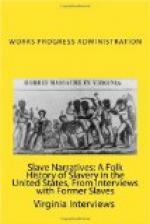“When I got older, I moved to Grenada and I come from there here. I was about thirty-five years old when I moved to Grenada. About 160 acres of land in Grenada was mine. I bought it, but heirs claimed the place and I had to leave. I had no land then, only a lot here and I came over here to look it over. A lady had come to Mississippi selling property and she had a plat which she said was in Little Rock not far from the capitol. Her name was Mrs. Putman. The place was on the other side of the Fourche. But I didn’t know that until I came here. She misguided me. I came to Arkansas and looked at the lot and didn’t want it. I made a trip over here twice before I settled on living in Little Rock. I told the others who had bought property from her the truth about its location. They asked me and I hate to lie. I didn’t knock; I just answered questions and didn’t volunteer nothing. They all quit making their payments, Just like I did. My land had a rock on it as big as a bale of cotton.
“Mr. Herring thought hard of me because I told the others the truth. I went into the office one day and Mr. Herring said, ’Parnell, I understand you have been knocking on me.’ I said, ’Well, I’ll tell you, Mr. Herring, if telling the truth about things is knocking on them, I certainly did.’ He never said anything more about it, and I didn’t either.
“I rented a place on Twelfth and Maple and then rented around there two or three times, and finally bought a place at 3704 West Twelfth Street. I moved to Little Rock March 18, 1911. That was twenty-seven years ago.
Parents
“My father was named Henry Parnell. He died in the year 1917 in the time of the great war. He was ninety-five years old when he died. His master had the same name. My mother’s name was Priscilla Parnell. She belonged to the same family as he did. They married before freedom. My father was a farmer and my mother was a housewife and she’d work in the field too.
“My grandmother on my mother’s side was named Hester Parnell. I don’t know what her husband’s name was. My mother, father, and grandmother were all from North Carolina. My grandmother did house and field work.
House
“My mother and father lived in a two-room house hewed out of big logs—great big logs. The logs were about four inches thick and twelve inches wide. It didn’t take many of them to build a wall—about ten or twelve of them on a side. They were notched down so as to almost come together. They chinked up the cracks with mud and covered it with a board.
“I laid in bed many a night and looked up through the cracks in the roof. Snow would come through there when it snowed and cover the bed covers. We thought you couldn’t build a roof so that it would keep out rain and snow, but we were mistaken. Before you would make a fire in them days, you had to sweep out the snow so that it wouldn’t melt up in the house and make a mess. But we kept healthy just the same. Didn’t have no pneumonia in those days.




